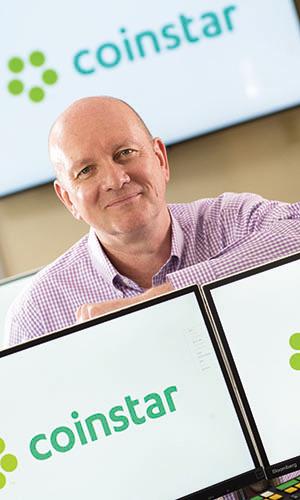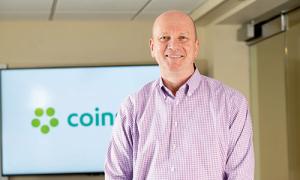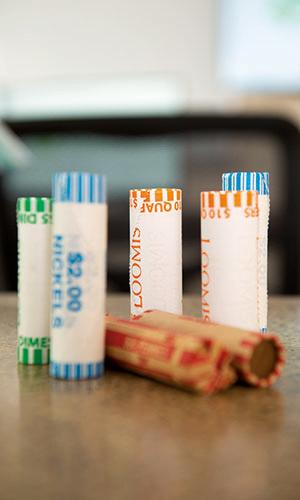In late 2000, Jim Gaherity ’82 was tracking shipments of cash as New England regional manager for armored car company Brinks, when he noticed something strange happening. Suddenly, the number of coins at processing centers had shot way up. “We went from something like 4 or 5 million to 20 million a month,” he says. “Something had changed dramatically.”

Photos by Kevin Harkins
He soon discovered what was behind that change: a new business, Coinstar, which was giving families a way to recycle coins that had been sitting unused in drawers, jars, and jugs. Through its kiosks in the front of grocery stores all over the country, it took coins and converted them into dollars—taking a small percentage in return. Gaherity flew out to the company’s headquarters in Seattle to talk about getting more of their business, and struck up a relationship. Eventually, they offered him a job. Now, as president and CEO of the company, Gaherity oversees a network of more than 20,000 coin machines in 11 countries worldwide.
Dealing in cash may seem like a losing proposition at a time when people go days without touching a dollar bill, much less a quarter—using debit cards for groceries, Apple Pay for coffee, Venmo for paying back friends. While cashless may be trending in some circles, Gaherity says don’t count out dollars and coins yet. According to the Federal Trade Commission, 25 percent of households in the United States are unbanked or under-banked. “Either don’t have a bank account, or can’t get access to credit,” Gaherity says. “So they are forced to use cash.” Put another way, 30 percent of all point-of-sale transactions in the United States are done with cash. In Europe, that number is 80 percent, and in Japan, it’s 90 percent.
That has created a prime opportunity in recent years for Gaherity to expand Coinstar’s business worldwide, as well as exploring new ventures—such as offering, just in the past few months, a chance for consumers to buy Bitcoin. As Gaherity explained to a business class at Saint Anselm in the fall of 2018, however, in order to stay profitable, he first had to turn the company around.
Making Every Coin Count
Gaherity grew up in Waterbury, Conn., where his father worked for the phone company—ironically, says Gaherity, “he was the manager in charge of payphone coin collection.” His mother also worked, as a manager for manufacturing companies for aluminum and brass. Through them, Gaherity inherited his strong work ethic, starting a paper route at age 12 and still hustling for jobs vacuuming and painting his condo complex. “I loved the fact that you could make money if you were aggressive,” he says.
Arriving at Saint Anselm in 1978, he found studies more difficult, but broke through with a basic computing class he took his junior year with business and economics assistant professor Bruce Mogayzel. By the next year, he was TA for the class. At the same time, he was taking classes in management and finance. “The toolset I got there really set the foundation to be able to walk out of the school and legitimately become a manager of people,” he says.
After graduating from Saint Anselm, Gaherity started his career as a terminal manager for a large freight company north of Boston, before getting a job as branch manager with Brinks in 1988, working his way up to New England regional manager. He joined Coinstar as director of North American operations in 2004, and became president of the company in 2015.

At that time, he had some hard choices to make. Over the years, Coinstar had expanded beyond the coin business to a whole array of grocery store kiosks—offering DVD rentals with Red Box, coffee with Rubi, and even a machine to list items on eBay called Gizmo. These subsidiaries rarely made money, however, and given the high cost of renting prime real estate for stores, the company decided to get rid of them one by one. “When Jim became president, he shuttered all of these unprofitable ventures that weren’t going anywhere, and started fighting to reinvest in the core business,” says Jeff Patterson, chief operating officer of the company, who had left Coinstar disillusioned but came back under Gaherity’s watch.
Not everyone was on board with the restructuring. Patterson says Gaherity convinced them by leading by example. “He would roll up his sleeves and get into the trenches and get dirty,” Patterson says, remembering how Gaherity went out into the field to dig into Rubi coffee machines to figure out why there weren’t working. “He never asked anyone to do anything he wouldn’t do himself.”
Gaherity admits he learned that way of managing people the hard way. Starting out in the black-and-white world of logistics, he developed a hard-charging style. “I was a hammer, and everything was a nail,” he says. “It was all get-this, do-this, don’t-do-that.” Over the years, however, he realized that being so direct turned people off, so he cultivated a style of management known as servant-leadership. “My job is to ensure that my direct reports have everything they need, because they are the experts in their area,” he says. “I’m there to support them.” As a testament to his success, Coinstar currently has only a 3 percent employee turnover rate, in a region where he’s competing with Amazon, Microsoft, and Facebook.
“ From a career perspective, Jim’s advice ‘to take more finance and marketing’ and to be willing to ‘go for an opportunity when it presents itself’ are words that our students will long remember.”
— Professor Duncan LaBay
Changing Bit by Bit
After successfully turning the company around, Gaherity turned it back to a “growth mindset.” With virtually no competitors, the company had cornered the domestic market, with nearly $3 billion in coins going through its system annually. However, in the overseas market, it had only made small inroads in just four companies. Gaherity began expanding rapidly, within three years adding seven new countries, either through new businesses or acquisitions.
“We’ve been on a tear to grab more land,” he says, getting up to speed on laws and regulations of different countries as they go.

In the United States, meanwhile, Gaherity has shifted focus from adding new machines that take up square footage to getting the most out of the machines they have. Since 2013, Coinstar has allowed customers to exchange coins for gift cards to major retailers instead of cash—without deducting any fee—and Gaherity has expanded to even more companies, including Starbucks, Nike, iTunes, and Southwest Airlines. Last year, Coinstar started giving customers the option of adding cash directly to their Amazon balance.
The biggest change the company has made is offering customers the opportunity to buy Bitcoin at its machines. Gaherity was leery at first about the prospect, given the currency’s association with illicit purchases on the “dark web.”
“I was very concerned about illegal uses like buying drugs or weapons,” says Gaherity, attributing his sense of business ethics to Saint Anselm’s early emphasis on Benedictine values. To avoid such associations, the company implemented controls to require customers to verify personal information before making Bitcoin transactions. “Those ‘know your customer’ procedures help to legitimize the product for good, while scaring away the bad actors,” Gaherity says. Since launching the service in January 2019, Gaherity says, it has taken off, with nearly $70,000 in sales daily.
Coinstar’s newest initiative is to offer “alternative financial services” that would allow unbanked customers to deposit cash into mobile checking and savings accounts. The company is also looking into offering loans so customers could avoid the exorbitant interest charged by predatory payday lenders. “We think we can democratize banking in this way, and give people better offerings than what they can get from these very expensive services,” Gaherity says.
Bringing it Back to the Hilltop
In all of these efforts, says Gaherity, the key has been to properly identify customers and segment markets to take advantage of the best opportunities as they present themselves—a point he stressed in November 2018 when he came to speak to a principles of marketing class taught by Professor Duncan LaBay. “Jim’s expertise in the fields of finance and marketing, as well as his remarkable knowledge of virtually every operational aspect of Coinstar, were very well received by our students,” says LaBay. “From a career perspective, his advice ‘to take more finance and marketing’ and to be willing to ‘go for an opportunity when it presents itself’ are words that our students will long remember.”
Gaherity says his hope was to convey to students that the “journey post-college can be extremely rewarding if you consider up-front what skills you need to develop in college, and how to apply these skills as you enter the working world.” He adds, “If your goal is to be a CEO or CFO, for example, you should ensure that finance is part of the curriculum to help you make the best financial decisions in the ever-complex business world.”
Being back on campus reminded him of what Saint Anselm did for him personally. “I believe that what I learned at this institution prepared me for my career, giving me the confidence that I could make a future for myself and have a positive impact for the community at large,” he says. “I would not have traded that experience for anything.”
